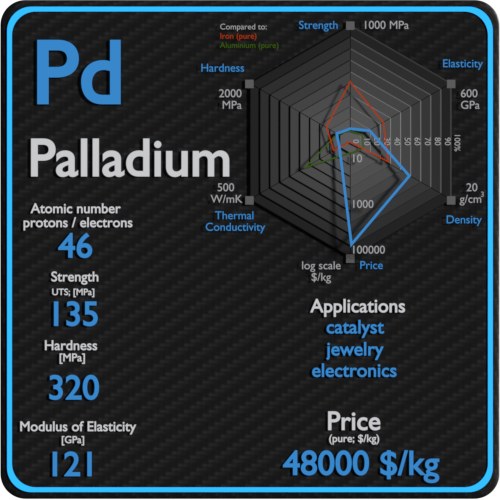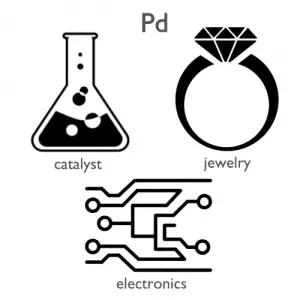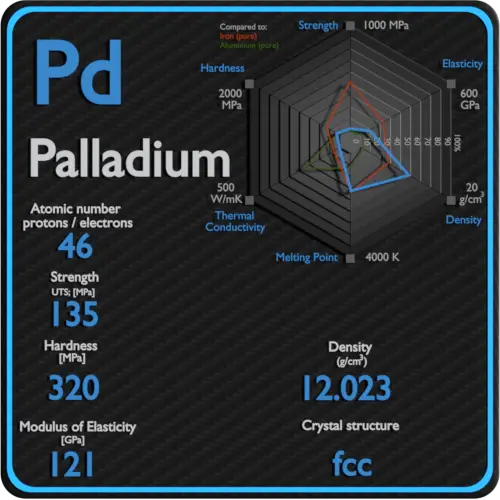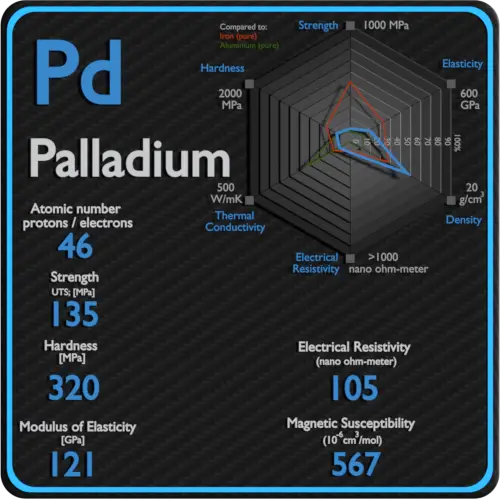About Palladium
Palladium, platinum, rhodium, ruthenium, iridium and osmium form a group of elements referred to as the platinum group metals (PGMs). These have similar chemical properties, but palladium has the lowest melting point and is the least dense of them. More than half the supply of palladium and its congener platinum is used in catalytic converters.
Summary
| Element | Palladium |
| Atomic number | 46 |
| Element category | Transition Metal |
| Phase at STP | Solid |
| Density | 12.023 g/cm3 |
| Ultimate Tensile Strength | 135 MPa |
| Yield Strength | 30 MPa |
| Young’s Modulus of Elasticity | 121 GPa |
| Mohs Scale | 4.8 |
| Brinell Hardness | 320 MPa |
| Vickers Hardness | 400 MPa |
| Melting Point | 1554.9 °C |
| Boiling Point | 2963 °C |
| Thermal Conductivity | 72 W/mK |
| Thermal Expansion Coefficient | 11.8 µm/mK |
| Specific Heat | 0.24 J/g K |
| Heat of Fusion | 17.6 kJ/mol |
| Heat of Vaporization | 357 kJ/mol |
| Electrical resistivity [nanoOhm meter] | 105 |
| Magnetic Susceptibility | +567e-6 cm^3/mol |
Applications of Palladium
More than half the supply of palladium and its congener platinum is used in catalytic converters, which convert as much as 90% of the harmful gases in automobile exhaust into less noxious substances. Palladium is also used in electronics, dentistry, medicine, hydrogen purification, chemical applications, groundwater treatment, and jewelry. Palladium-based alloys are being extensively used in fuel cell technology applications. The metal is also employed in historic photographic printing process. Palladium has been used as a precious metal in jewelry since 1939 as an alternative to platinum in the alloys called “white gold”.
Production and Price of Palladium
Raw materials prices change daily. They are primarily driven by supply, demand and energy prices. In 2019, prices of pure Palladium were at around 48000 $/kg.
As overall mine production of palladium reached 208,000 kilograms in 2016, Russia was the top producer with 82,000 kilograms, followed by South Africa, Canada and the U.S. Russia’s company Norilsk Nickel ranks first among the largest palladium producers globally, accounting for 39% of the world’s production. The most important commercial sources are nickel-copper deposits found in the Sudbury Basin, Ontario, and the Norilsk–Talnakh deposits in Siberia.
Source: www.luciteria.com
Mechanical Properties of Palladium
Strength of Palladium
In mechanics of materials, the strength of a material is its ability to withstand an applied load without failure or plastic deformation. Strength of materials basically considers the relationship between the external loads applied to a material and the resulting deformation or change in material dimensions. In designing structures and machines, it is important to consider these factors, in order that the material selected will have adequate strength to resist applied loads or forces and retain its original shape. Strength of a material is its ability to withstand this applied load without failure or plastic deformation.
For tensile stress, the capacity of a material or structure to withstand loads tending to elongate is known as ultimate tensile strength (UTS). Yield strength or yield stress is the material property defined as the stress at which a material begins to deform plastically whereas yield point is the point where nonlinear (elastic + plastic) deformation begins.
See also: Strength of Materials
Ultimate Tensile Strength of Palladium
Ultimate tensile strength of Palladium is 135 MPa.
Yield Strength of Palladium
Yield strength of Palladium is 30 MPa.
Modulus of Elasticity of Palladium
The Young’s modulus of elasticity of Palladium is 30 MPa.
Hardness of Palladium
In materials science, hardness is the ability to withstand surface indentation (localized plastic deformation) and scratching. Brinell hardness test is one of indentation hardness tests, that has been developed for hardness testing. In Brinell tests, a hard, spherical indenter is forced under a specific load into the surface of the metal to be tested.
Brinell hardness of Palladium is approximately 320 MPa.
The Vickers hardness test method was developed by Robert L. Smith and George E. Sandland at Vickers Ltd as an alternative to the Brinell method to measure the hardness of materials. The Vickers hardness test method can be also used as a microhardness test method, which is mostly used for small parts, thin sections, or case depth work.
Vickers hardness of Palladium is approximately 400 MPa.
Scratch hardness is the measure of how resistant a sample is to permanent plastic deformation due to friction from a sharp object. The most common scale for this qualitative test is Mohs scale, which is used in mineralogy. The Mohs scale of mineral hardness is based on the ability of one natural sample of mineral to scratch another mineral visibly.
Palladium is has a hardness of approximately 4.8.
See also: Hardness of Materials
Palladium – Crystal Structure
A possible crystal structure of Palladium is face-centered cubic structure.
In metals, and in many other solids, the atoms are arranged in regular arrays called crystals. A crystal lattice is a repeating pattern of mathematical points that extends throughout space. The forces of chemical bonding causes this repetition. It is this repeated pattern which control properties like strength, ductility, density, conductivity (property of conducting or transmitting heat, electricity, etc.), and shape. There are 14 general types of such patterns known as Bravais lattices.
See also: Crystal Structure of Materials
Crystal Structure of Palladium

Thermal Properties of Palladium
Palladium – Melting Point and Boiling Point
Melting point of Palladium is 1554.9°C.
Boiling point of Palladium is 2963°C.
Note that, these points are associated with the standard atmospheric pressure.
Palladium – Thermal Conductivity
Thermal conductivity of Palladium is 72 W/(m·K).
The heat transfer characteristics of a solid material are measured by a property called the thermal conductivity, k (or λ), measured in W/m.K. It is a measure of a substance’s ability to transfer heat through a material by conduction. Note that Fourier’s law applies for all matter, regardless of its state (solid, liquid, or gas), therefore, it is also defined for liquids and gases.
Coefficient of Thermal Expansion of Palladium
Linear thermal expansion coefficient of Palladium is 11.8 µm/(m·K)
Thermal expansion is generally the tendency of matter to change its dimensions in response to a change in temperature. It is usually expressed as a fractional change in length or volume per unit temperature change.
Palladium – Specific Heat, Latent Heat of Fusion, Latent Heat of Vaporization
Specific heat of Palladium is 0.24 J/g K.
Heat capacity is an extensive property of matter, meaning it is proportional to the size of the system. Heat capacity C has the unit of energy per degree or energy per kelvin. When expressing the same phenomenon as an intensive property, the heat capacity is divided by the amount of substance, mass, or volume, thus the quantity is independent of the size or extent of the sample.
Latent Heat of Fusion of Palladium is 17.6 kJ/mol.
Latent Heat of Vaporization of Palladium is 357 kJ/mol.
Latent heat is the amount of heat added to or removed from a substance to produce a change in phase. This energy breaks down the intermolecular attractive forces, and also must provide the energy necessary to expand the gas (the pΔV work). When latent heat is added, no temperature change occurs. The enthalpy of vaporization is a function of the pressure at which that transformation takes place.
Palladium – Electrical Resistivity – Magnetic Susceptibility
Electrical property refers to the response of a material to an applied electric field. One of the principal characteristics of materials is their ability (or lack of ability) to conduct electrical current. Indeed, materials are classified by this property, that is, they are divided into conductors, semiconductors, and nonconductors.
See also: Electrical Properties
Magnetic property refers to the response of a material to an applied magnetic field. The macroscopic magnetic properties of a material are a consequence of interactions between an external magnetic field and the magnetic dipole moments of the constituent atoms. Different materials react to the application of magnetic field differently.
See also: Magnetic Properties
Electrical Resistivity of Palladium
Electrical resistivity of Palladium is 105 nΩ⋅m.
Electrical conductivity and its converse, electrical resistivity, is a fundamental property of a material that quantifies how Palladium conducts the flow of electric current. Electrical conductivity or specific conductance is the reciprocal of electrical resistivity.
Magnetic Susceptibility of Palladium
Magnetic susceptibility of Palladium is +567e-6 cm^3/mol.
In electromagnetism, magnetic susceptibility is the measure of the magnetization of a substance. Magnetic susceptibility is a dimensionless proportionality factor that indicates the degree of magnetization of Palladium in response to an applied magnetic field.


























